I love Spain. The moment I arrive, I find myself relaxing into the laid back, low-key attitude that makes it so different from the UK.
I also return again and again for creative inspiration — Spanish cities have appeared in a number of my ARKANE thrillers — and of course, the food is some of the best in the world, but they don’t shout about it so you need to do your research to avoid the more touristy places. I almost moved here in the late 1990s but headed for Australia instead. It would have been a different life indeed …
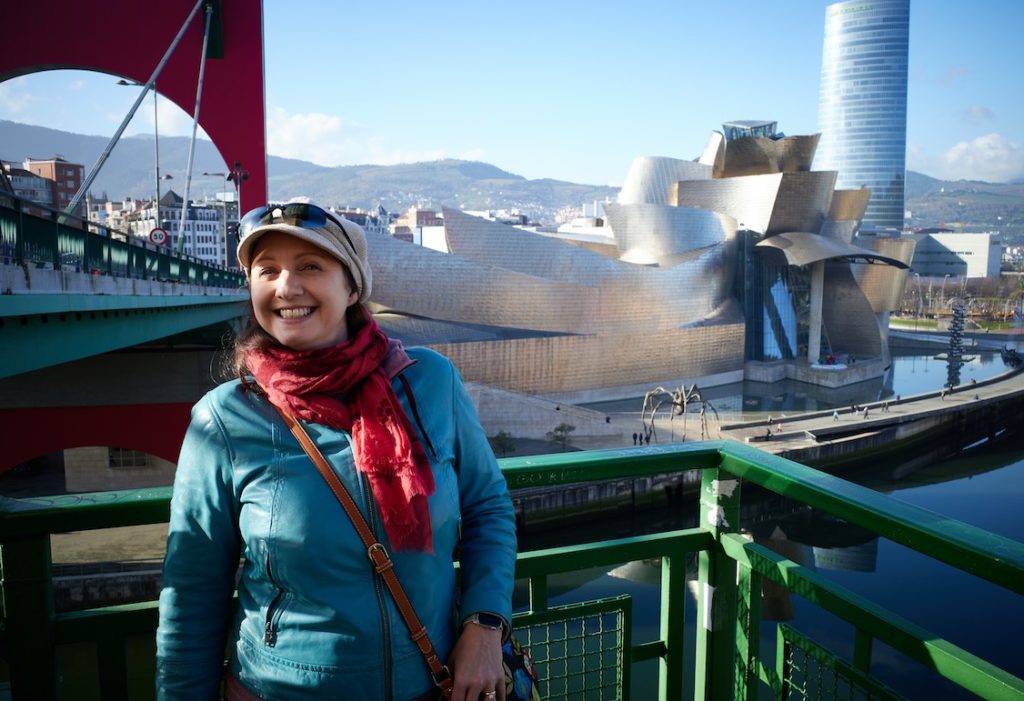
For this trip in early February 2020, I went with my husband (and photographer/business partner). We had four days in San Sebastian and Bilbao — a taste of the Basque country. In this article, I’ll share some of the cultural and culinary highlights in case you’d like to visit.
- What is Basque?
- Guggenheim Museum, Bilbao
- Maman by Louise Bourgeois, Anselm Kiefer, and more of the art within
- Promenade by the bay in San Sebastian and climb Mount Urgull
- Enjoy pintxos and txakoli … plus Michelin star dining
- Where to stay and how to get there
- Recommended books about Basque culture or set in the region
What is Basque?
The Basque people are a distinct European group, many of whom speak the Basque language (Euskara), share a common culture and a genetic heritage. The ‘Basque country’ spans north-central Spain, through the Pyrenees and into south-west France, and is one of the oldest ethnic groups in Europe.
You will notice immediately on arriving in the region that all the signs are in two languages — Basque and Spanish. Basque is full of strange letter combinations to the English and it’s very different from Spanish. In fact, the Basque language is “unrelated to the other languages of Europe.” [Wikipedia].
When you visit Bilbao and San Sebastian, you are in Spain so you can speak Spanish — and most places have menus in English — but if you want to embrace the local culture, try a little Basque. Pintxos (pinch-os) instead of tapas is a good start!
One evening in Bilbao, we came across a group of Basque in traditional dress, men with the txapela, a beret-style hat, and women in zapi, a headscarf. They carried sticks and thumped the ground while singing as they walked the city, apparently for a local festival.
[For more on the language, read Behind the Basques: The Most Misunderstood Culture in Europe on Medium.]
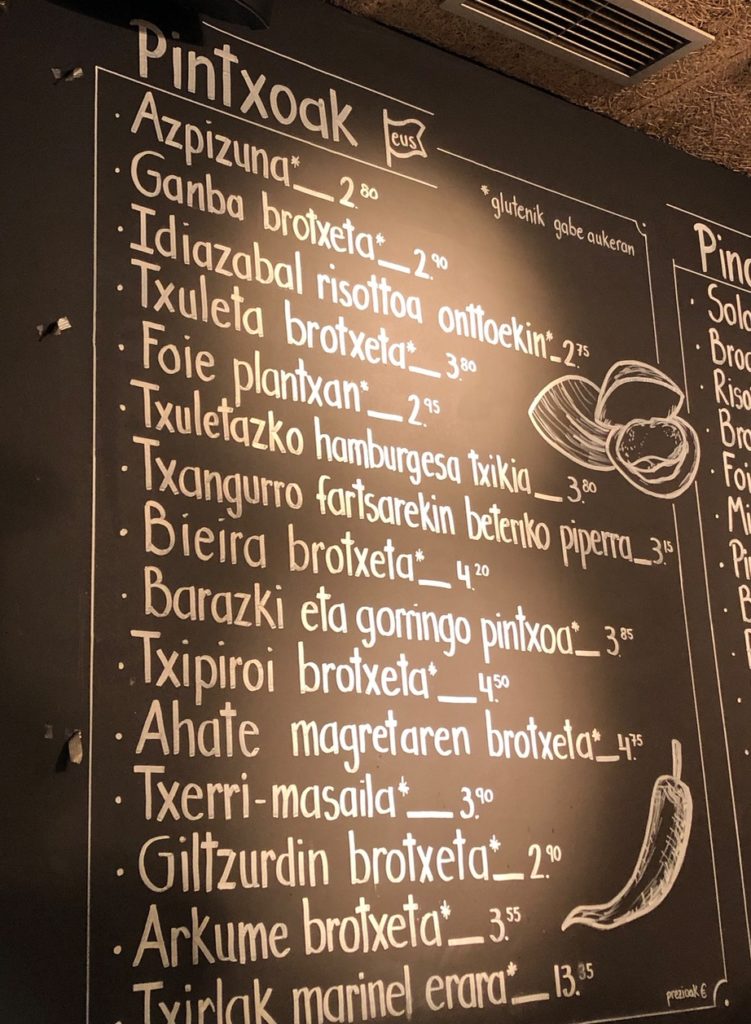
The Guggenheim — inside and out
This short trip was planned around the Guggenheim Museum and it is one of the main reasons people visit the region, so be sure to check its opening times. It’s closed on Mondays and it’s definitely worth booking tickets in advance, especially if you’re visiting during the high season (May-Sept).
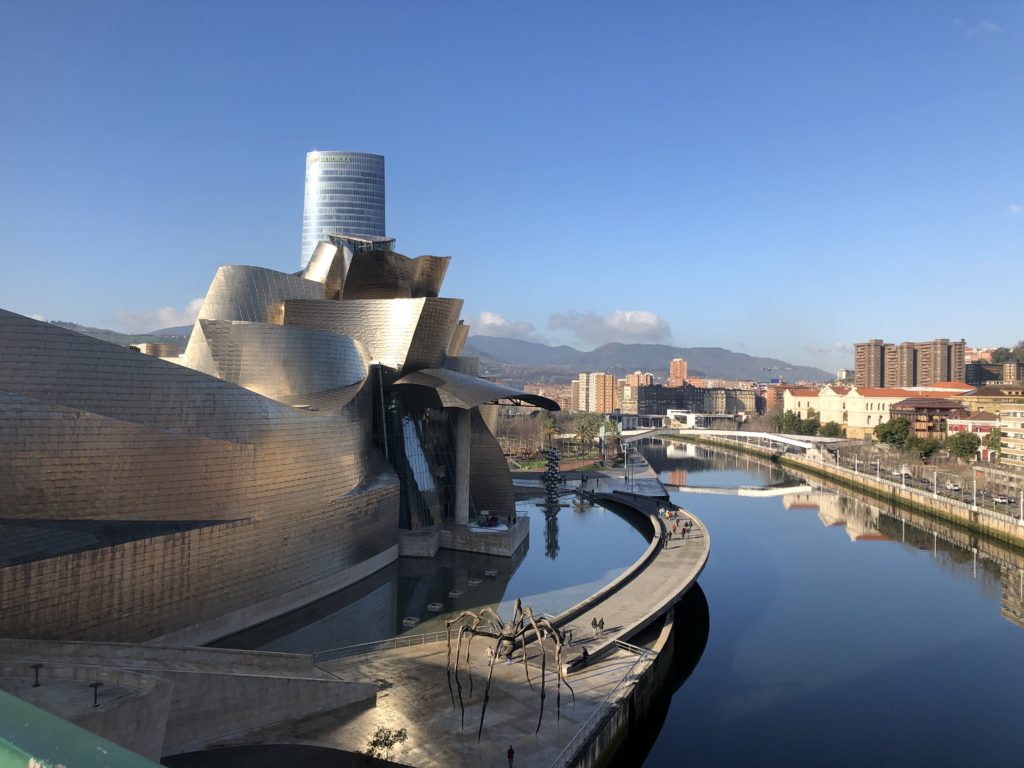
The building was designed by architect Frank Gehry and no picture can encapsulate its entirety because it changes from every angle.
I’m a huge modern architecture fan so we walked around the exterior in different lights over different days. We had one day of rain and two of sun, so we were able to see it shift. From the nearby bridge, it can seem like a ship, part of Bilbao’s industrial port heritage.
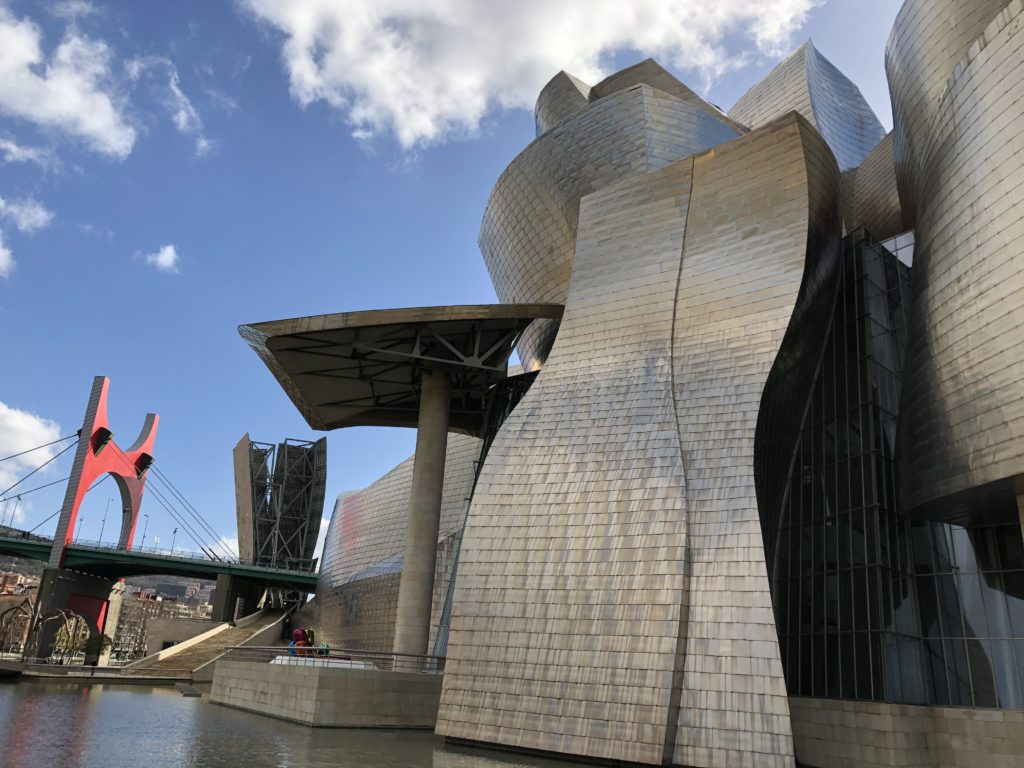
From below, it is a curved sculpture in the changing light. It’s hard to look at anything else other than the building itself and it’s well worth going just for that.
Maman by Louise Bourgeois, Anselm Kiefer, and more of the art within
But of course, the Guggenheim also has permanent art installations and a shifting array of temporary exhibitions.
I first saw Maman by Louise Bourgeois 20 years ago at the Tate Modern and I have never forgotten it. The version outside the Guggenheim is a bronze cast.
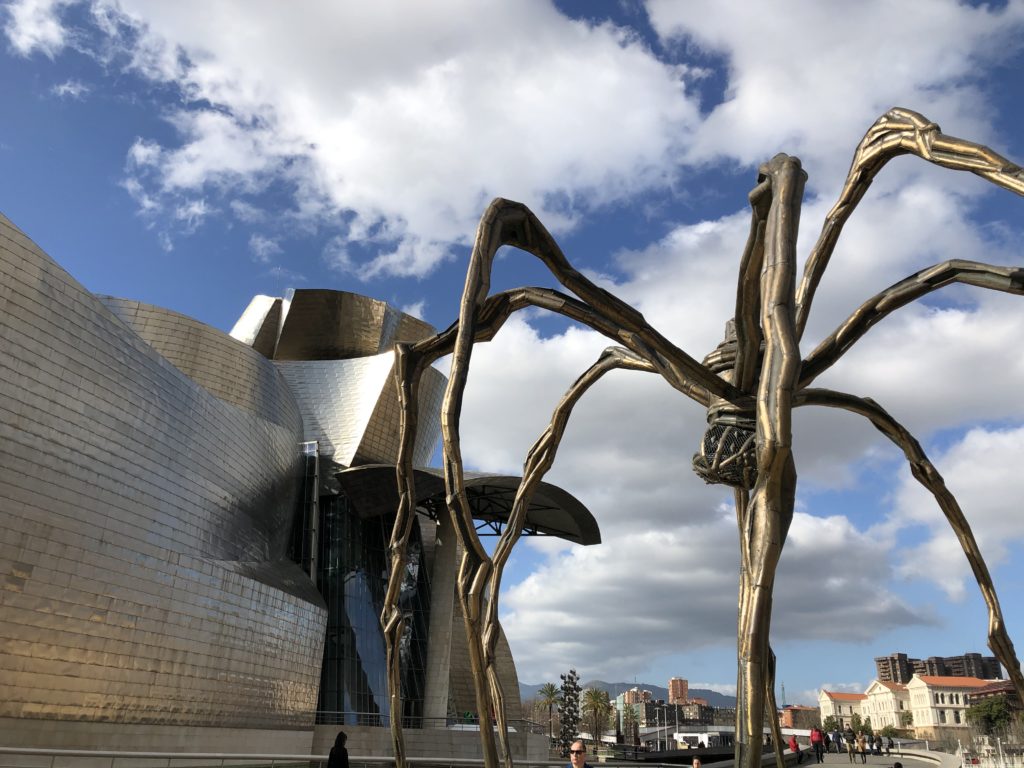
The name itself is part of the shock of the sculpture for me. Louise has said of it,
“The Spider is an ode to my mother. She was my best friend. Like a spider, my mother was a weaver. My family was in the business of tapestry restoration, and my mother was in charge of the workshop. Like spiders, my mother was very clever. Spiders are friendly presences that eat mosquitoes. We know that mosquitoes spread diseases and are therefore unwanted. So, spiders are helpful and protective, just like my mother.” [Tate Modern]
You can, of course, choose to read that with sub-text! The spider is anything but protective when walking there in the evening, with the FOG installation drifting over the cloudy riverside. It felt a little Stranger Things …
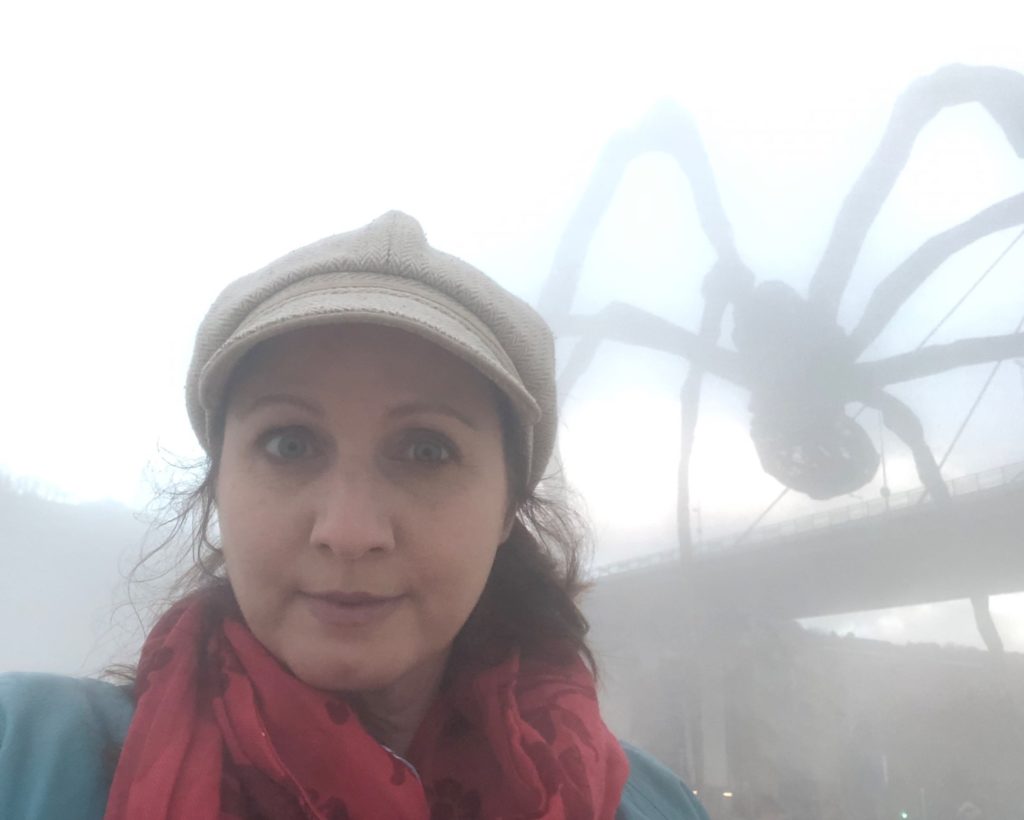
Modern art galleries are always a wonderful artist’s date for me, mainly because I don’t know what to expect from the exhibits. One of the installations is Richard Serra’s The Matter of Time, a series of giant steel plates curved to different dimensions. The weathering colors make it starkly beautiful, but once you walk through its corridors, you realize its true nature is to manipulate sound and visual perception. Physically disturbing and challenging — as modern art should be, perhaps.
I also visit galleries for art to put in my novels. I go with an open mind and see what resonates, what might hold a deeper meaning that I can delve into for my story. On our last trip to Spain, I found Bruegel’s Triumph of Death at the Prado in Madrid which ended up in Valley of Dry Bones. This time, I discovered Anselm Kiefer’s The Land of Two Rivers, where the Tigris and Euphrates meet. It looks unremarkable in the photos, but in real life, it is more like a sculpture that draws you into the rusting, salted water. I am just starting to consider where it might fit into my next ARKANE thriller but the seeds have been sown …
Promenade by the bay in San Sebastian
It was unseasonably gorgeous weather for early February. 22 degrees C and the beach soon filled with sunbathers and swimmers while locals walked the promenade.
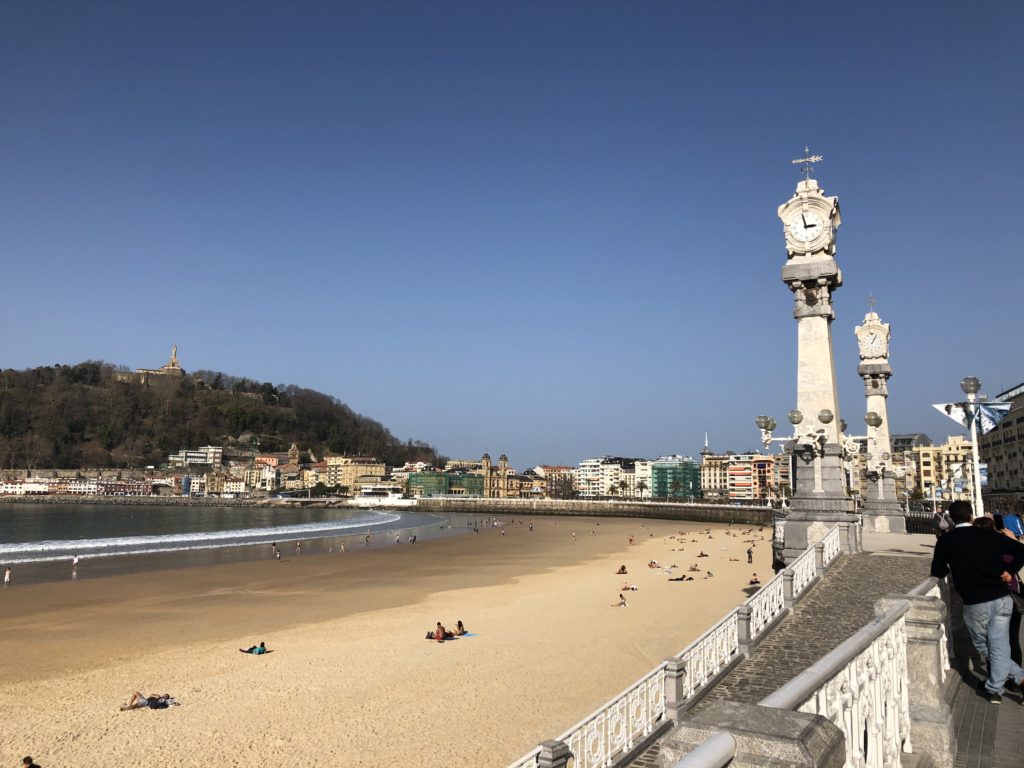
It’s worth walking to the top of Mount Urgull to La Mota castle for the views across the bay and the city, then down to the aquarium and back along past the tiny port with its colorful fishing boats. It’s about 90 minutes’ walk at a leisurely pace with lots of photo stops.
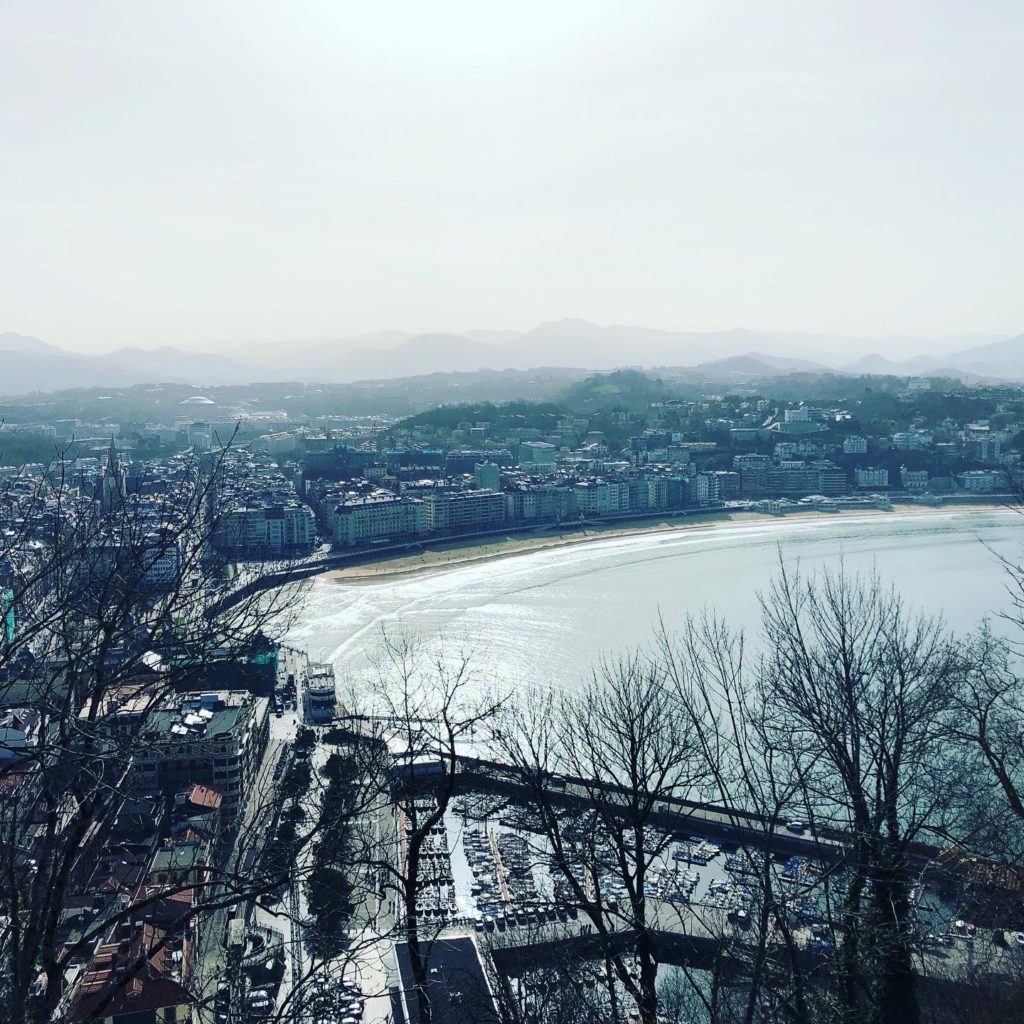
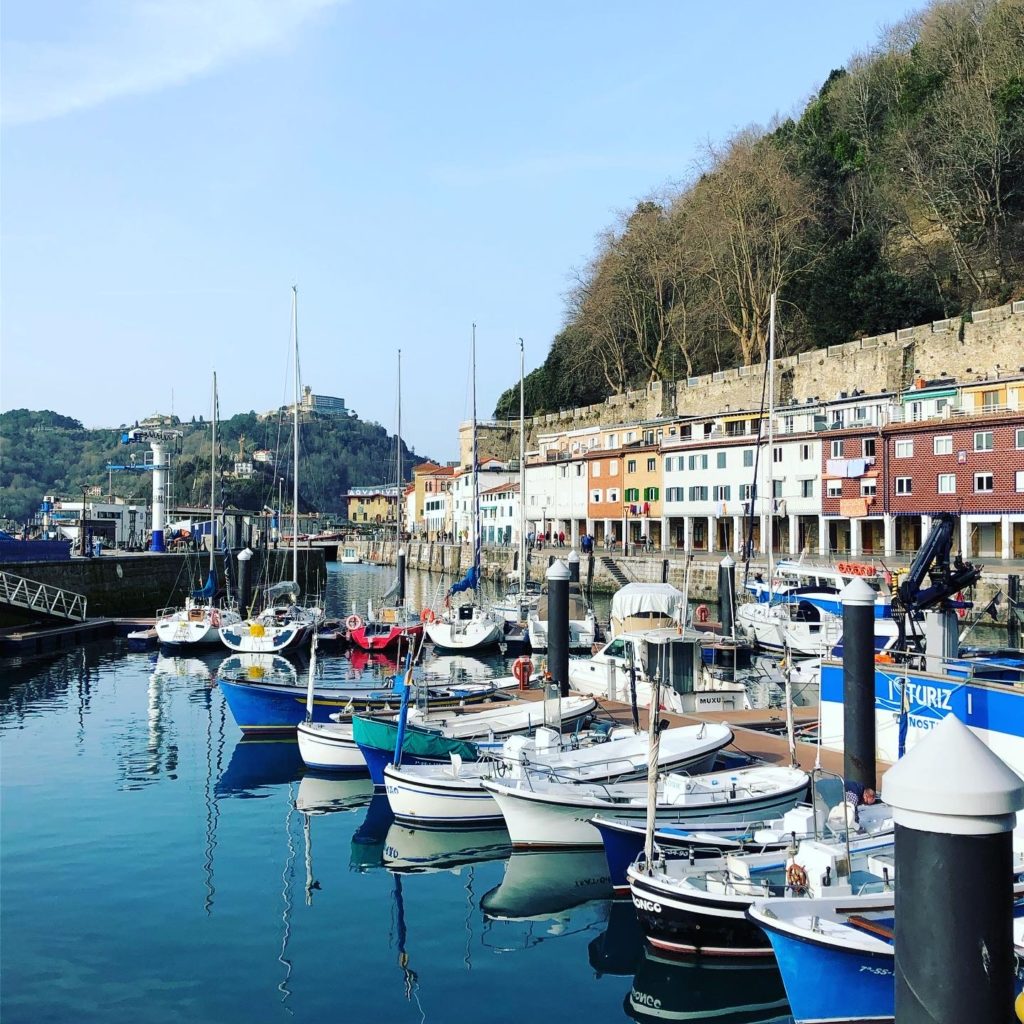
Pintxos and txakoli … plus Michelin star dining
The food is one of the main attractions of the region, so be ready to indulge. Here are some of our favorite places and pintxos.
Pintxos Gilda and a glass of txakoli. We started most lunch and dinner times with these piquant pintxos of manzanilla olive, anchovy and marinated guindilla pepper, sometimes served with cheese. Txakoli (chako-li) is the local refreshing white wine. It’s low alcohol, so you can have several glasses … Most pintxos are served with a side of bread, some of which is absolutely delicious, so take a break from low carb while you’re there.
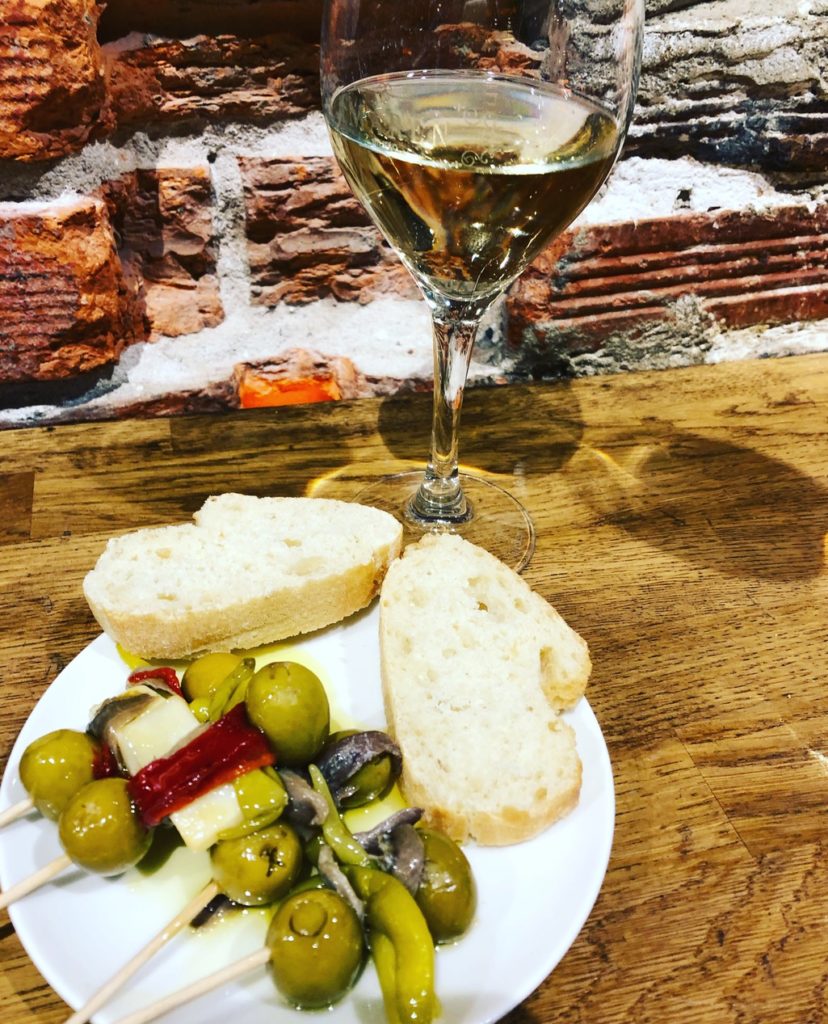
KATA4, San Sebastian. If you love seafood, there are way too many options for a short trip. It’s worth trying the Txangurro spider crab which is a specialty of the region. I’m an oyster fan so I tried a mixed platter. It included arcachon, gillardeau, del eo n2, utah beach, plana belon, and marennes. All wonderful with a glass of txakoli.
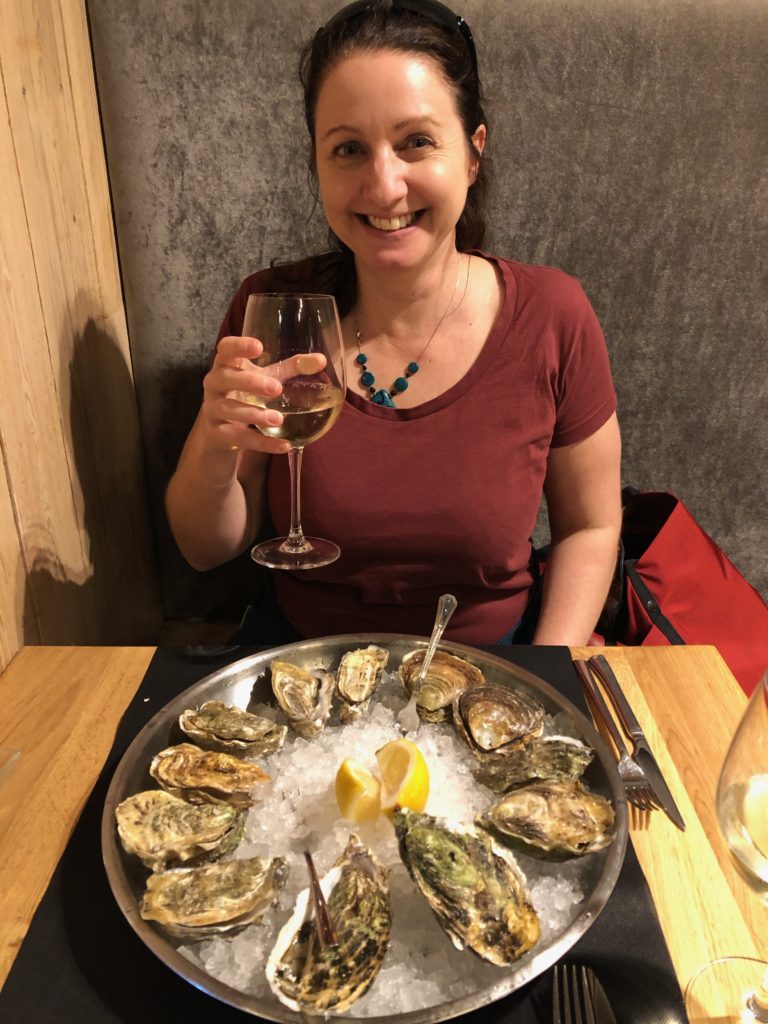
La Cuchara de San Telmo, San Sebastian. This backstreet bar has a few tables but it’s mostly standing room only. The staff are used to tourists and can suggest some of the specials of the day, as well as wine. It’s not like other places as there are no dishes on the bar. All are freshly cooked. We had a dish of perfectly seared scallops, then hake in a lightly spiced sauce, and beef cheeks washed down with a glass of Albariño. This was one of the best places we ate in the area. Highly recommended.
Bodega Donostiarra, San Sebastian. This place is over the river so it was full of locals with fantastic food. There are plenty of options for carnivores including txuleta, perfectly cooked rib steak, served with a baked potato, olive oil and red peppers. Certainly big enough for two.
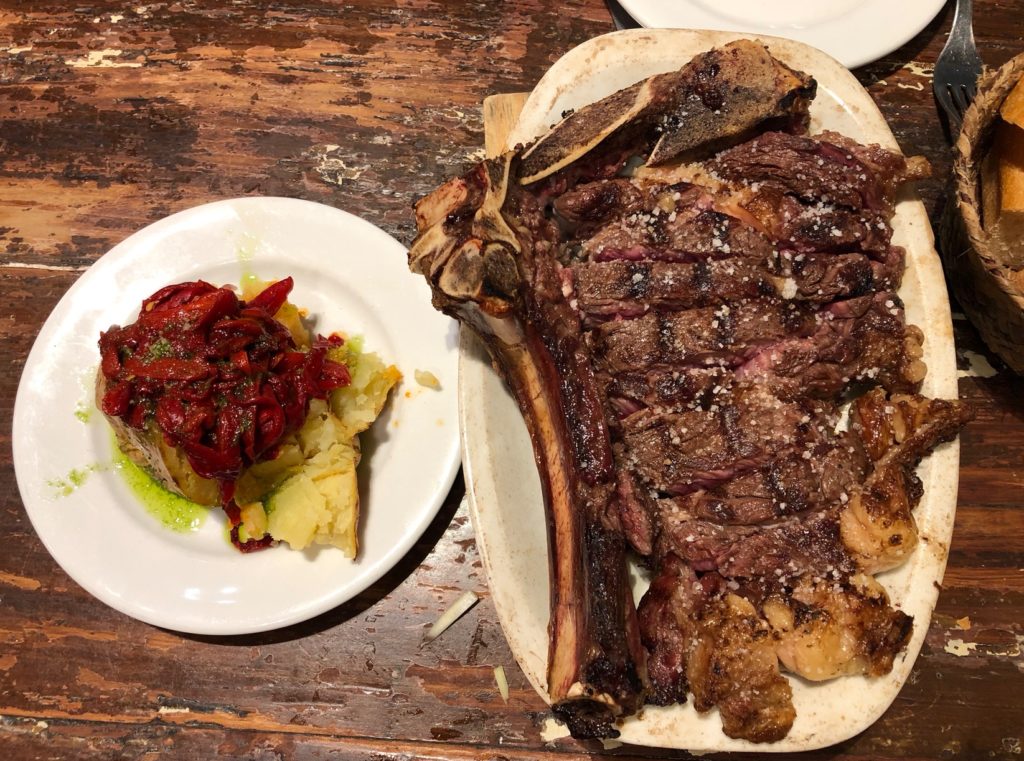
La Viña, San Sebastian. You must save some space for the baked cheesecake here. I’m not even a cheesecake fan but this was divine. You only need one plate between two as you get double slices.
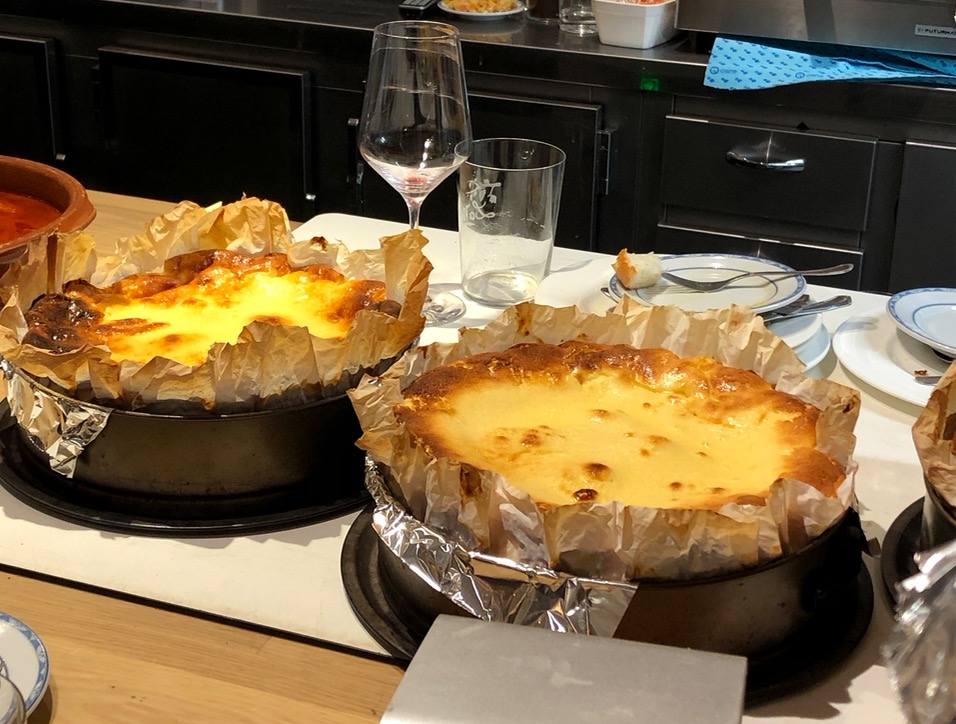
La Viña del Ensanche, Bilbao. We just popped in here for lunch and it turned out to be far better than expected given the low key atmosphere. Try the croquettes and the Josellinis au gratin (for carnivores), as well as the asparagus tempura. For pudding, anything with the cheesecake ice cream on the side.
Amaren, Bilbao. Famous for its meat, you can even order ox steaks which are huge. They do pintxos and wine in the front bar area if you can’t get into the restaurant.
Baster, Bilbao. This is just a tiny pintxos bar near the side of the cathedral in the old town, but it served the best patatas bravas I’ve had for a while along with perfect tomato bread and jamon. Sit in the sun and enjoy a small beer and watch life go by.
Mina, Bilbao. Some say there are more Michelin starred restaurants in this area than anywhere else in the world, but even off-season, you have to book well in advance for the famous ones. If you want to get into Azurmendi or Mugaritz, it’s worth booking them first (three months in advance) and then booking flights and accommodation. We looked for places last minute and very much enjoyed Mina, set by the side of the river opposite the Mercado de la Ribera. The tasting menu was all local and delicious, and the wine list was extraordinary.
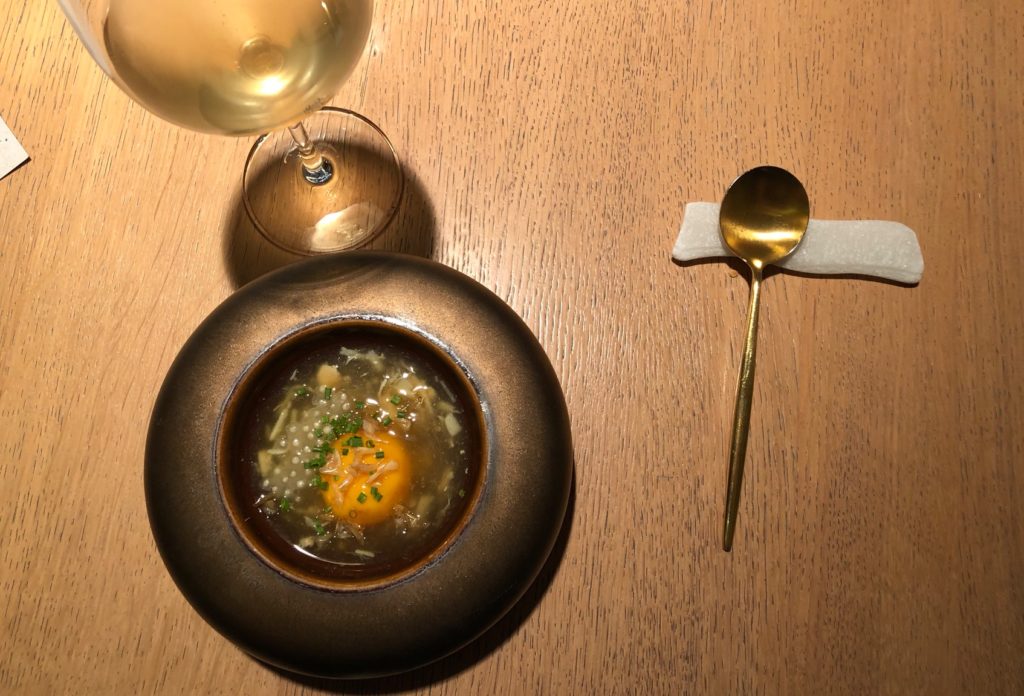
Where to stay and how to get there
The airport is only 15 mins from the heart of Bilbao by taxi (around 25 EUR) and you can also get a bus that goes from outside the terminal.
You can get a bus to San Sebastian from Bilbao airport which takes about 1 hour 20 minutes (17 EUR) and goes every hour from outside the terminal. You can also get a bus between San Sebastian and Bilbao central bus station which is also about 1 hour 20 mins (13 EUR). You need to buy a ticket for a specific time slot.
We stayed at the Hotel Room Mate Gorka in San Sebastian, centrally situated with a view over the park, and an easy 8 minute walk from the bus station. It has boutique modern facilities with a breakfast room in the basement. Because it was off-season (early February), we were able to upgrade our room for a small charge.
We stayed at the Gran Hotel Domine in Bilbao, which was fantastic with great service and a breakfast room on the roof overlooking the Guggenheim. We also got an upgrade to a room with a designer bathroom. [I love off-season travel!] I don’t usually think hotel breakfasts are worth it, but this one has a perfect selection of healthy, delicious food and unlimited coffee refills.
You can walk to the old town in around 20 minutes along the riverside and it’s only 15 minutes walk to the best pintxos bars. We didn’t hire a car so stayed within walking distance of all we wanted to see. There are buses and taxis for anything longer or in bad weather.
Both hotels offered USB ports in the bedroom so a European continental power adaptor wasn’t even necessary. This is becoming more usual in hotels now, but it’s always worth carrying an adaptor just in case.
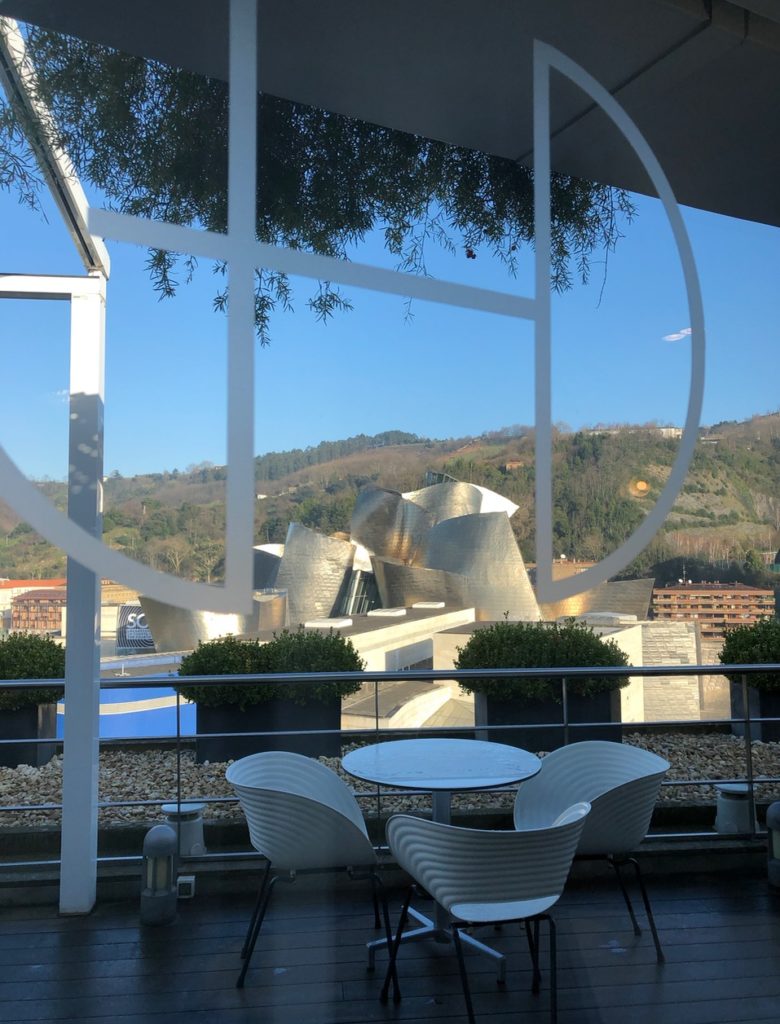
Recommended books about Basque culture or set in the region
The Basque History of the World – Mark Kurlansky. Straddling a small corner of Spain and France in a land that is marked on no maps except their own, the Basques are a puzzling contradiction—they are Europe’s oldest nation without ever having been a country. No one has ever been able to determine their origins, and even the Basques’ language, Euskera—the most ancient in Europe—is related to none other on earth. For centuries, their influence has been felt in nearly every realm, from religion to sports to commerce. Today, the Basques are enjoying what may be the most important cultural renaissance in their long existence.
Basque: Spanish recipes from San Sebastian and beyond – Jose Pizarro. In Basque, José Pizarro shows readers how to create some of the best-loved dishes from this area at home, including traditional Basque dishes such as bacalao (salt cod with pisto and allioli), hake “a la plancha” with oven potatoes and Romesco sauce, and wild mushrooms with scrambled eggs. He dispels the myth that creating tapas and traditional Spanish fare is a laborious task, and shows you how to bring the great experience of dining in the little bars of San Sebastián to your own kitchen.
Guernica – Dave Boling. In 1935, Miguel Navarro finds himself on the wrong side of the Spanish Nationalists, so he flees to Guernica, the most ancient town of the Basque region. In the midst of this idyllic, isolated bastion of democratic values, Miguel finds more than a new life-he finds a love that not even war, tragedy or death can destroy.
Obabakoak: Stories from a village – Bernardo Atxaga. A shimmering, mercurial collection about life in Obaba, a remote, exotic Basque village … Hints of darker undercurrents mingle with moments of wry humor in this dazzling collage of stories, town gossip, diary excerpts, and literary theory, all held together by Bernardo Atxaga’s distinctive and tenderly ironic voice.
The Invisible Guardian – Dolores Redondo. A taut, gripping psychological thriller follows a police inspector who reluctantly returns to her hometown in Spain’s Basque Country—a place shrouded in mythology and superstition—to solve a series of eerie murders. Book 1 in the Trilogía del Baztán series.
If you want to try some of my thrillers which feature aspects of Spain, check out Gates of Hell (Granada, Cordoba, Barcelona), and Valley of Dry Bones (Toledo, Madrid, Mallorca).
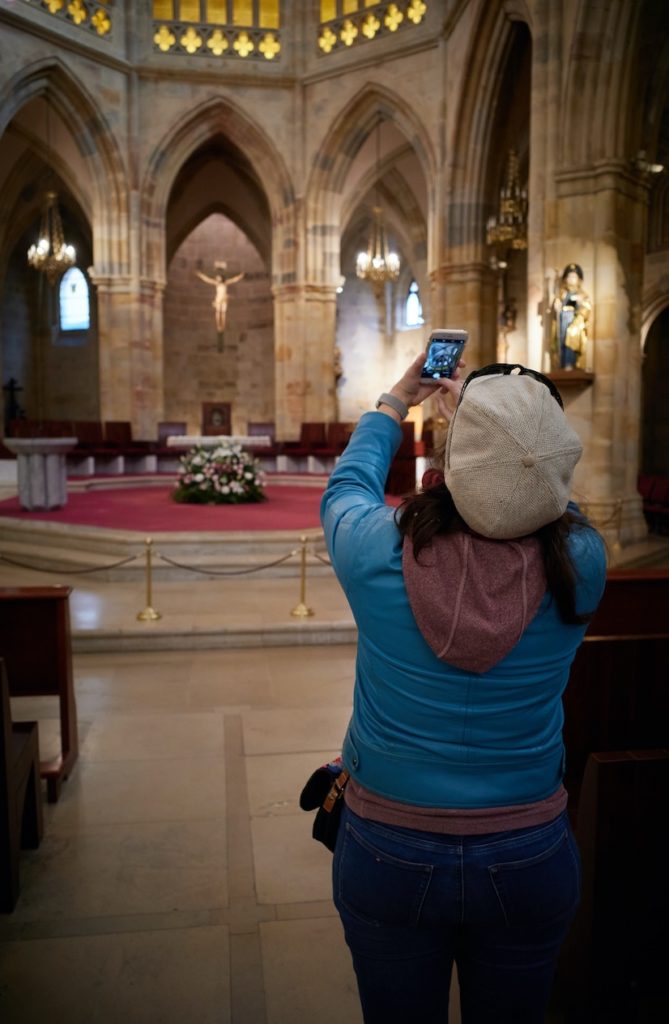
Pin this!


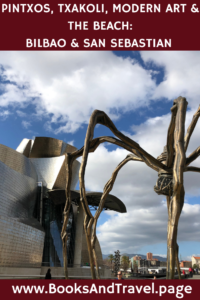
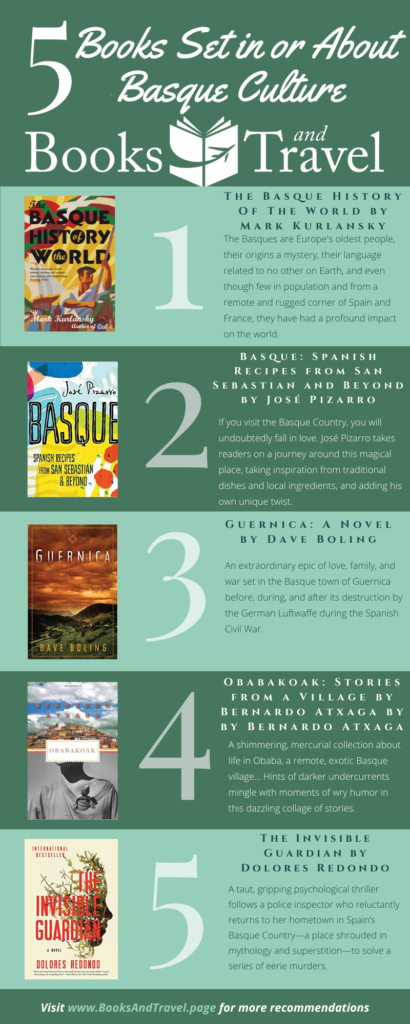
Beautiful trip, 2 of kids were there last year , my wife have decided it’s on our bucket list! Enjoy the rest of your trip!
Tom
I went off season to Bilbao and San Sebastian a couple of years ago and your article has just reminded me of that wonderful trip, thanks Jo!!
If you love art, food, history, walks and the coast then I would recommend a trip to this region of Spain.
Hopefully, some of the landmarks will appear in your writing soon!!
Gotta love off-season travel!
Nice to look at those images and the tasty food of course. 🙂
It makes the time go faster until we will be there too this year. Well, nearby.
We will be in northern Spain too, but more to the left, heading for Asturias.
Yet, we won’t be visitors there who enjoy the area for a limited time. We settle there for good. Asturias will be our new home. 🙂 Once we’ve settled and all the formalities are done and over with, I finally will have time to continue with my writing there. I’m sure Asturias will be a great inspiration. 🙂
Hans
Lovely to hear you will be making a home in Asturias, Hans!
AS Always great experience and pictures.
This post made me miss the Basque Country so much (we lived there for two years). You hit some of our favourite places and I’m noting down some ones we missed.
Hopefully we will revisit next year (Elkar, the Basque publisher has picked up three of my kids’ books to be translated into Basque, woo-hoo!).
(I love Gilda’s – see link.)
Glad you liked it – we are doing Gildas again on Friday for Valentine’s day – can’t get enough!